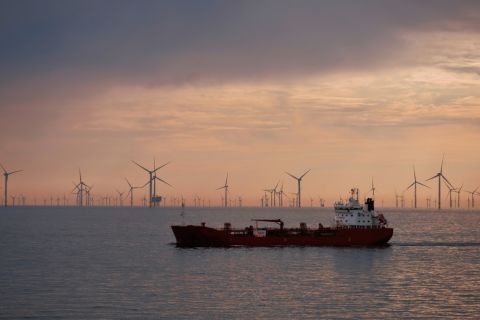Learn more about Hart Energy Conferences
Get our latest conference schedules, updates and insights straight to your inbox.
Market fundamentals and impending emissions regulation demand that the shipping industry take the next step in formalizing and professionalizing its approach to sustainability—including LNG applications.
That will reflect its increasing importance as a business-critical asset, said Tony Teo, business development director, Maritime North America, for Det Norske Veritas (DNV). Teo spoke at a Hart Energy Breakfast Club in Houston, August 2.
As bunker prices rise, difficult market conditions persist and regional carbon-emissions regulations strengthen, minimizing carbon-management risk and encouraging shipping to become more sustainable and share this transparently with all key stakeholders will be increasingly critical to securing a competitive advantage.
Managing carbon emissions risk is, therefore, at the crux of the challenge facing shipowners, who need expert support to navigate the strategic management of carbon emissions, said Teo.
Although the connection between sustainability and commercial success is strengthening and the shipping industry is gradually preparing for imminent regulation, that focus must increase, Teo added.
"LNG as a marine fuel is technologically proven and safe. The small-scale application as a marine fuel was developed by DNV in 2000," he noted. "We have rules that are based on our experience on how to safely and efficiently build or retrofit and operate a vessel to 'LNG fuel' or even 'LNG fuel-ready.'"
Asked how he would describe the state of the LNG industry currently, Teo said: "It is the star industry. LNG carrier rates have gone through the roof, while some other ship segments are below-water.
"This is driven by two issues: The increased cost of fuel and the focus on cleaner air-emissions globally," he explained. "In the U.S., we're fortunate to have an abundance of shale gas and the interest on LNG-fuel applications toward the ECA [emissions-control area]—which came into force on August 1, 2012 – makes a lot of sense."
The current maritime fuel era is no doubt changing, Teo said.
"It took about 100 years to switch from sails to coal-powered steam ships and another 50 years or so to switch to fuel oil. These were driven by technology and economics," he said. "But times have changed, and there is another driver—the International Maritime Organization Marpol VI regulations for ECA and global-emission limits—and there will be more ECAs coming.
This will also accelerate as soon as the IMO MBM (Market-Based Measures) starts to be implemented. Discussions on carbon trading and a levy system are on the table at ongoing MBM meetings for ships that do not meet the IMO EEDI (Energy Efficiency Design Index) and SEEMP (Ship Energy Efficiency Management Plan) requirements, Teo continued. "These will come into force from January 2013 for new and existing ships, respectively. And once again, LNG fuel emerges as the most favorable option."
The ECA extends 200 nautical-miles from North American shores and includes all inland waterways (including the Great Lakes) as well as portions of Alaska and Hawaii. This applies to all ships in the U.S. ECA, including vessels registered to nations that are not party to Marpol Annex VI, according to Teo.
The shipping industry arguably faces "massive challenges"—in particular, the rising cost of fuel, added Teo. By 2015, as much as 80% of the daily costs of owning and operating a ship will involve fuel.
"Today, fuel typically accounts for between 40% and 70% of a vessel's operating cost depending on the type and speed among other [things]," he explained. "With the ECA's limit of 0.1% S sulfur by 2015 and Marpol Annex VI global requirement for 0.5% sulfur by 2020, the demand and cost of the ultra-low sulfur fuel will surely increase given that on the supply side, the number of refineries producing such fuel is not foreseen to be increasing proportionally.
"The refining industry is dependent on the price of crude oil, which will increase, as the world's population and economy grow. This is one market that is seen to be unattractive," Teo said.
Domestic ships in North America essentially have three options to meet new emissions-control regulations: install scrubbers, burn low-sulfur fuel or switch to LNG fuel for the ship's propulsion, according to Liisa Kiuru, executive director of Hart Energy's International Fuel Quality Center.
"Such requirements are being implemented gradually and will be in full force by 2015 and 2016, leaving shipowners a limited number of options for modifications to their ships so as to continue trading in North America," she explained.
Without a well-structured and formal emissions-reduction program, revenue can be at risk or lost from carbon costs, Teo added.
"LNG is the most desirable as it satisfies all the tough air emission regulations coming up. The toughest one, the 'Tier-III,' NOx [nitrogen oxide] reduction by about 80% from 'Tier I,' for new ships built from 2016 is still a technological and engineering challenge," he said. "LNG fuel will comply with this Tier-III NOx [nitrogen oxide] requirement.
Scrubbers for sulfur oxide (SOx) reduction present a different set of challenges—in terms of available space, additional power generation and the number of pumps and tanks needed, Teo said.
"In addition, it requires close monitoring and recording to comply with the regulation. This is a new and relatively immature technology for marine use, and there are significant uncertainties—particularly on costs and expected cost reductions due to learning effects– which are high in the initial stages of technology innovation," he said. "Novel technologies are notoriously hard to predict. Depending on the types, both SOx and NOx abatement methods would require chemical consumables, and the prices of these have increased."
For those reasons, scrubbers will likely have a limited uptake until the global sulfur limit is enforced in 2020, according to Teo.
"The reason is that a low LNG price compared to HFO [heavy fuel oil] favors investing in gas engines rather than in scrubbers, and there is a limited proportion of the global fleet that spends enough time in ECAs to justify a costly system to be retrofitted," he explained. "After 2020, when the global sulfur limit enters into force, the picture will change [when] ships are required to run on low-sulfur fuel or clean the exhaust all the time. Scrubbers may then potentially be fitted to more ships."
Although LNG presents a compelling case, it hasn't spread further and faster, because LNG is not available to most ships when and where they need it, Teo noted.
"The main showstopper would be the infrastructure. This requires huge investment in the order of at least $100 million for a small-scale liquefaction plant. Without governmental incentives and support, this is limited to oil majors, gas utilities and other organizations with access to huge capital," he said. "But this presents a huge business opportunity for companies with the muscle to hold as shipowners start making decisions to convert or build to LNG fuel. Once the infrastructure is available, DNV predicts that the ship market will follow."
Recommended Reading
US Gulf Coast Heavy Crude Oil Prices Firm as Supplies Tighten
2024-04-10 - Pushing up heavy crude prices are falling oil exports from Mexico, the potential for resumption of sanctions on Venezuelan crude, the imminent startup of a Canadian pipeline and continued output cuts by OPEC+.
Veriten’s Arjun Murti: Oil, Gas Prospectors Need to Step Up—Again
2024-02-08 - Arjun Murti, a partner in investment and advisory firm Veriten, says U.S. shale provided 90% of global supply growth—but the industry needs to reinvent itself, again.
Paisie: Economics Edge Out Geopolitics
2024-02-01 - Weakening economic outlooks overpower geopolitical risks in oil pricing.
Global Oil Demand to Grow by 1.9 MMbbl/d in 2024, Says Wood Mac
2024-02-29 - Oil prices have found support this year from rising geopolitical tensions including attacks by the Iran-aligned Houthi group on Red Sea shipping.
Russia Orders Companies to Cut Oil Output to Meet OPEC+ Target
2024-03-25 - Russia plans to gradually ease the export cuts and focus on only reducing output.


